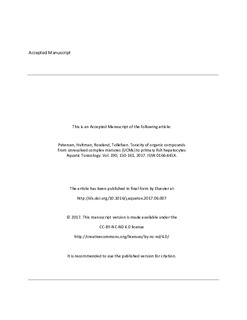| dc.description.abstract | Many environmental matrices contaminated with organic pollutants derived from crude oil or degraded petroleum contain mixtures so complex that they are typically unresolved by conventional analytical techniques such as gas chromatography. The resulting chromatographic features have become known as ‘humps’ or unresolved complex mixtures (UCMs). These UCMs often dominate the organic contaminants of polluted environmental samples: for example, in oil sands produced water up to 150mgL−1 of ‘naphthenic acids’ appear as UCMs when examined by gas chromatography as the esters. In oil-contaminated mussels, aromatic hydrocarbon UCMs may comprise almost all of the total toxic hydrocarbons, with over 7000μgg−1 dry weight reported in some samples. Over the last 25 years, efforts to resolve and thus identify, or at least to produce average structures, for some UCM components, have proved fruitful. Numerous non-polar UCM hydrocarbons and more polar UCM acids have been identified, then synthesised or purchased from commercial suppliers. As UCMs have been proposed to represent a risk to aquatic organisms, the need for assessment of the ecotoxicological effects and characterisation of the mode of action (MoA) of these environmental pollutants has arisen. In the present study, several chemicals with structures typical of those found in some UCMs, were assessed for their potential to disrupt membrane integrity, inhibit metabolic activity, activate the aryl hydrocarbon receptor (AhR), and activate the estrogen receptor (ER) in primary rainbow trout hepatocytes (Oncorhynchus mykiss). These endpoints were determined in order to screen for common toxic modes of action (MoA) in this diverse group of chemicals. The results from the in vitro screening indicated that of the endpoints tested, the predominant toxic MoA was cytotoxicity. EC50 values for cytotoxicity were obtained for 16 compounds and ranged from 77μM–24mM, whereof aliphatic monocyclic acids, monoaromatic acids, polycyclic monoaromatic acids and alkylnaphthalenes were the most toxic. The observed cytotoxicity of the chemicals correlated well with the hydrophobicity (LogKOW) suggesting that the toxicity was predominantly due to a non-specific MoA. Interestingly, two compounds induced the ER-mediated production of vitellogenin (Vtg) and six compounds induced the AhR-mediated Ethoxyresorufin-O-deethylase (EROD) enzymatic activity to >20% of the positive control; by doing so suggesting that they may act as ER or AhR agonists in fish. The heterogeneous group of ‘UCM compounds’ tested exhibited multiple MoA that may potentially cause adverse effects in fish. Additional studies to determine if these compounds may cause adverse effects in vivo at environmentally relevant concentrations, are warranted to identify if such compounds are indeed of potential environmental concern. | nb_NO |

